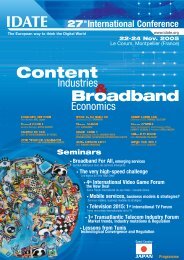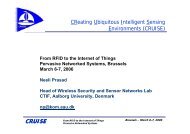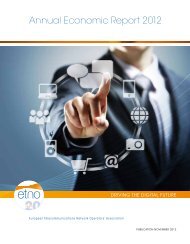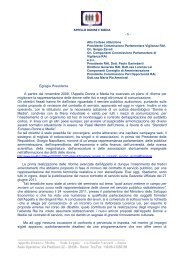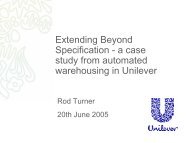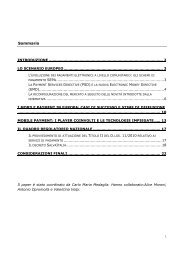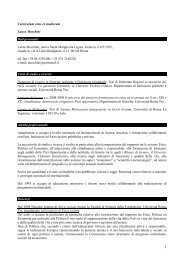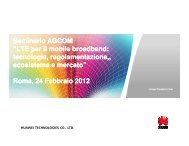LTE technologies
LTE technologies
LTE technologies
Create successful ePaper yourself
Turn your PDF publications into a flip-book with our unique Google optimized e-Paper software.
Security<br />
Level:<br />
Seminario AGCOM<br />
“<strong>LTE</strong> per il mobile broadband:<br />
tecnologia, regolamentazione,<br />
ecosistema e mercato”<br />
Roma, 24 Febbraio 2012<br />
PARTE II: Tecnologia <strong>LTE</strong><br />
www.huawei.com<br />
Fabio Moresi<br />
Country Marketing – Wireless<br />
fabio.moresi@huawei.com<br />
HUAWEI TECHNOLOGIES CO., LTD.
Contents<br />
Part I<br />
• <strong>LTE</strong> Regulation<br />
• <strong>LTE</strong> Market<br />
• <strong>LTE</strong> Ecosystem<br />
Part II<br />
• <strong>LTE</strong> basics<br />
• <strong>LTE</strong> field performance<br />
• Interference<br />
• <strong>LTE</strong> –A evolution<br />
HISILICON HUAWEI TECHNOLOGIES SEMICONDUCTOR CO., LTD. Page 2
<strong>LTE</strong> Flat Architecture<br />
• 3G RNC (inherited from the 2G<br />
BSC) disappears from eRAN<br />
› eNB directly connected to<br />
ePC (S1 i/f)<br />
› RNC features distributed<br />
between eNB and ePC (MME<br />
and S-GW)<br />
• Simpler architecture (fewer nodes<br />
of different types) → simplified<br />
operation<br />
• Termination of L2 @ eNB → lower<br />
latency<br />
• 3GPP does not require any<br />
physical architecture for ePC<br />
implementation but typically one<br />
platform for User Plane (S-GW &<br />
P-GW) and one for Control Plane<br />
(MME)<br />
HISILICON HUAWEI TECHNOLOGIES SEMICONDUCTOR CO., LTD. Page 3
code<br />
Evolution of Radio Interface<br />
Frequency Division Multiple Access<br />
Time Division Multiple Access<br />
TACS<br />
GSM<br />
freq<br />
Code Division Multiple Access<br />
Orthogonal Frequency Division<br />
Multiple Access<br />
UMTS<br />
<strong>LTE</strong><br />
freq<br />
HISILICON HUAWEI TECHNOLOGIES SEMICONDUCTOR CO., LTD. Page 4
<strong>LTE</strong> fundamentals<br />
• Radio Interface<br />
TTI: 1ms<br />
System Bandwidth<br />
Sub-carriers<br />
• DownLink = OFDMA<br />
Frequency<br />
• UpLink = SC-FDMA<br />
User 1<br />
User 2<br />
Time<br />
Sub-band:12Sub-carriers<br />
User 3<br />
• Antenna System Solutions<br />
DL<br />
UL<br />
• Diversity<br />
• Multi-port transmission (MIMO)<br />
• Beam-forming<br />
Multi-element<br />
Transmitter<br />
eNB<br />
N<br />
Multi-element<br />
Receiver<br />
M<br />
UE<br />
• Spectrum Flexibility<br />
• Flexible bandwidth<br />
• New and legacy bands<br />
• FDD and TDD technology<br />
From 1.4MHz to 20MHz<br />
HISILICON HUAWEI TECHNOLOGIES SEMICONDUCTOR CO., LTD. Page 5
OFDM basics<br />
• The basic “module” of OFDM is the narrowband<br />
subcarrier or tone<br />
∆f =1/T<br />
frequency<br />
• Each OFDM symbol consist of the sum of N<br />
orthogonal subcarriers with 15KHz granularity<br />
frequency<br />
• At each freq instant, only one subcarrier is<br />
different from zero orthogonal tones<br />
HISILICON HUAWEI TECHNOLOGIES SEMICONDUCTOR CO., LTD. Page 6
OFDM (Orthogonal Frequency Division Multiplexing)<br />
as Multi-User Access technique<br />
subcarrier<br />
freq<br />
∆f<br />
• Resource allocated to user “red”<br />
timeslot (TS =0.5 msec)<br />
subframe TTI (= 2 TS = 1 msec)<br />
frame (= 10 TTI = 20 TS = 10 msec)<br />
∆f = 15KHz (Tsampling =32,5nsec)<br />
HISILICON HUAWEI TECHNOLOGIES SEMICONDUCTOR CO., LTD. Page 7
OFDM (Orthogonal Frequency Division Multiplexing)<br />
Principles<br />
...<br />
freq<br />
HISILICON HUAWEI TECHNOLOGIES SEMICONDUCTOR CO., LTD. Page 8
Inter-Symbol Interference – Cyclic Prefix<br />
OFDMA<br />
Symbol 1<br />
OFDMA<br />
Symbol 2<br />
ISI area<br />
Symbol 1 Symbol 2<br />
Symbol 1<br />
time<br />
guard time<br />
Symbol 1 Symbol 2<br />
Guard band, no ISI !<br />
Copy<br />
Symbol 1<br />
time<br />
Only CP affected by ISI<br />
time/ bandwidth lost<br />
Page 9<br />
HISILICON HUAWEI TECHNOLOGIES SEMICONDUCTOR CO., LTD. Page 9
Time frame structure<br />
time<br />
TTI0<br />
TTI1<br />
TTI2<br />
TTI3<br />
TTI7<br />
TTI8<br />
TTI9<br />
TS 0 TS 1<br />
TS 2 TS 3<br />
TS 4 TS 5<br />
TS 6 TS 7<br />
...<br />
TS 14 TS 15<br />
TS 16 TS 17<br />
TS 18 TS 19<br />
normal<br />
Cyclic<br />
Prefix<br />
frame<br />
~0,5 msec = 15360 * Tsampling<br />
CP0 Tuseful 0 CP1 Tuseful 1 CP2 Tuseful 2 ... CP6 Tuseful 6<br />
~5,2µsec ~66,7µsec ~4,7µsec ~66,7µsec ~4,7µsec ~66,7µsec ~4,7µsec ~66,7µsec<br />
160 * Tsampling 2048 * Tsampling 144 * Tsampling<br />
OFDM symbol<br />
• The normal CP frame consists of 7 OFDM symbol<br />
• An extended CP frame also exist (ECP =~16,7µsec; 6 OFDM symbol)<br />
• Cyclic Prefix acts as “time guard” against inter-symbol interference but of course<br />
implies to decrease radio efficiency<br />
HISILICON HUAWEI TECHNOLOGIES SEMICONDUCTOR CO., LTD. Page 10
Bandwidth Flexibility<br />
1.4 MHz 3MHz 5MHz 10 MHz 15 MHz 20 MHz<br />
• Higher out-of-band emission wrt<br />
WCDMA<br />
• 10% of guard bands to be considered<br />
• One subcarrier “occupies” 15KHz (∆f)<br />
1.4MHz 3MHz 5MHz 10MHz 15MHz 20MHz<br />
Theroretical number<br />
of subcarriers<br />
Number of occupied<br />
subcarriers *<br />
Effective BW<br />
allocated<br />
~93,3 200 ~333,3 ~666,6 1000 ~1333,3<br />
72 180 300 600 900 1200<br />
1.08MHz 2.7MHz 4.5MHz 9MHz 13.5MHz 18MHz<br />
* = DC subcarrier non considered<br />
HISILICON HUAWEI TECHNOLOGIES SEMICONDUCTOR CO., LTD. Page 11
Resource Block<br />
Resource block consists of 12 consecutive subcarriers (180KHz) and one timeslot<br />
12 subcarriers = 180KHz<br />
∆f<br />
freq<br />
∆f<br />
• Resource Element<br />
• 84 (12*7) Resource Elements per<br />
Resource Block<br />
1.4MHz 3MHz 5MHz 10MHz 15MHz 20MHz<br />
Number of occupied<br />
subcarriers *<br />
Number of Resource<br />
Blocks<br />
72 180 300 600 900 1200<br />
6 15 25 50 75 100<br />
HISILICON HUAWEI TECHNOLOGIES SEMICONDUCTOR CO., LTD. Page 12
Modulation Schemes<br />
1,1<br />
01,11<br />
101,100<br />
0 … 1 00 … 11<br />
000 … 111<br />
QPSK<br />
• 2 bits/symbol<br />
16 QAM<br />
• 4 bits/symbol<br />
64 QAM<br />
• 6 bits/symbol<br />
HISILICON HUAWEI TECHNOLOGIES SEMICONDUCTOR CO., LTD. Page 13
OFDM Transmitter<br />
s [n]<br />
Serial<br />
to<br />
Parallel<br />
...<br />
Modulation<br />
. .<br />
. .<br />
. .<br />
. .<br />
. .<br />
. .<br />
. .<br />
. .<br />
... IFFT ...<br />
Parallel<br />
to<br />
Serial<br />
CP<br />
insert<br />
Digital<br />
to<br />
Analog<br />
v(t)<br />
frequency domain<br />
time domain<br />
HISILICON HUAWEI TECHNOLOGIES SEMICONDUCTOR CO., LTD. Page 14
Y<br />
e<br />
a<br />
r<br />
MIMO technology<br />
• Different data streams sharing same frequency and time<br />
• 3GPP Standard consider different MIMO combination 2x2, 4x2 , 4x4,.. which can<br />
theoretically increase 2-4 times the throughput of a single transmission<br />
• For MIMO 2x2 (2 antenna ports at Transmitter and 2 RX antenna porta at receiver), the<br />
common implementation is to use the two different polarization of a X-pol antenna<br />
Page 15<br />
HISILICON HUAWEI TECHNOLOGIES SEMICONDUCTOR CO., LTD. Page 15 Page 15
Control Resources and Reference Signals<br />
• The first 3 OFDM symbols of every second TS (with exception of Reference Elements)<br />
are used for control channels.<br />
Control Resources<br />
Reference Signals<br />
Reference Signals reserved for<br />
other antenna ports<br />
HISILICON HUAWEI TECHNOLOGIES SEMICONDUCTOR CO., LTD. Page 16
OFDM – Peak to Average Power Ratio<br />
• OFDM signals have a higher peak-to-average ratio (PAR)—often called a peak-toaverage<br />
power ratio (PAPR)—than single-carrier signals do. The reason is that I<br />
• In time domain, a multicarrier signal is the sum of many narrowband signals., thus<br />
OFDM symbols have a higher peak-to-average power ratio (PAPR)<br />
• High value of PAPR implies high level of linearity and power consumption for<br />
transmitters. This can be critical for UEs.<br />
• In UPLINK a slight different mechanism of OFDM has been developed, called Single<br />
Carrier FDMA<br />
HISILICON HUAWEI TECHNOLOGIES SEMICONDUCTOR CO., LTD. Page 17
Single Carrier FDMA (UL)<br />
• SC-FDMA can be viewed as a special OFDMA system with the user’s signal preencoded<br />
by discrete Fourier transform (DFT), hence also known as DFT-pre-coded<br />
OFDMA or DFT-spread OFDMA.<br />
• One prominent advantage of SC-FDMA over OFDMA is the lower PAPR (peak-toaverage<br />
power ratio) of the transmit waveform , which benefits the mobile users in<br />
terms of battery life and power efficiency.<br />
• The same modulation schemes of DL are considered for UL, but currently UEs don’t<br />
support yet 64QAM (Cat 5)<br />
freq<br />
N x ∆f<br />
HISILICON HUAWEI TECHNOLOGIES SEMICONDUCTOR CO., LTD. Page 18
FDD and TDD frame structure<br />
FDD<br />
time<br />
DL<br />
fDL<br />
UL<br />
TTI 0 TTI 1 TTI 2 TTI 3 TTI 4 TTI 5 TTI 6 TTI 7 TTI 8 TTI 9<br />
fUL<br />
TDD<br />
DL<br />
UL<br />
time<br />
TTI 0 TTI 1 TTI 2 TTI 3 TTI 4 TTI 5 TTI 6 TTI 7 TTI 8 TTI 9<br />
fDL and fUL<br />
Special<br />
frame for<br />
DL/UL sync<br />
• The sampling rate in both FDD and TDD is the same and both <strong>technologies</strong> operate<br />
under a 1-ms sub-frame and 0.5ms timeslot definition.<br />
• Main differences between the two modes are<br />
• Frame 0 and frame 5 (always downlink in TDD)<br />
• Frame 1 and frame 6 is always used as for synchronization in TDD<br />
• Frame allocation for Uplink and Downlink is settable in TDD<br />
• Several frame combinations are defined for TDD standard<br />
HISILICON HUAWEI TECHNOLOGIES SEMICONDUCTOR CO., LTD. Page 19
<strong>LTE</strong> FDD DL peak throughput - calculation example<br />
Working assumption:<br />
• FDD channel 20MHz,<br />
• 64QAM modulation scheme<br />
• 2x2 MIMO mechanism<br />
7 OFDM symbols per TS<br />
12 subcarrier per Resource Block<br />
2 TS per sub-frame (1msec)<br />
- [ 8 OFDM elements used per Reference Signals<br />
(MIMO 2x2)<br />
+ 20 OFDM elements used per control channels ]<br />
(7 x 12 x 2 – 8 - 20)<br />
140 OFDM symbols<br />
per TTI<br />
6 bits per OFDM symbol (64QAM)<br />
840 bit/msec<br />
100 Radio Blocks per 20MHz channel<br />
2 antenna ports (2x2MIMO)<br />
- Synch Signal part<br />
~150Mbps<br />
(840 x 100 x 1000 x 2 -<br />
Synch)<br />
HISILICON HUAWEI TECHNOLOGIES SEMICONDUCTOR CO., LTD. Page 20
<strong>LTE</strong> FDD peak throughput - examples<br />
• DL FDD channel 20MHz,<br />
• 64QAM modulation scheme<br />
• 2x2 MIMO mechanism<br />
~150Mbps<br />
• DL FDD channel 20MHz,<br />
• 64QAM modulation scheme<br />
• 4x4 MIMO mechanism<br />
~300Mbps<br />
• DL FDD channel 15MHz,<br />
• 64QAM modulation scheme<br />
• 2x2 MIMO mechanism<br />
~115Mbps<br />
• UL FDD channel 20MHz,<br />
• 64QAM modulation scheme<br />
• no MIMO mechanism<br />
~75Mbps<br />
• UL FDD channel 20MHz,<br />
• 16QAM modulation scheme<br />
• no MIMO mechanism<br />
~50Mbps<br />
Note: Cat 3 UE support 100/50Mbps (DL/UL)<br />
HISILICON HUAWEI TECHNOLOGIES SEMICONDUCTOR CO., LTD. Page 21
Contents<br />
Part I<br />
• <strong>LTE</strong> Regulation<br />
• <strong>LTE</strong> Market<br />
• <strong>LTE</strong> Ecosystem<br />
Part II<br />
• <strong>LTE</strong> basics<br />
• <strong>LTE</strong> field performance<br />
• Interference<br />
• <strong>LTE</strong> –A evolution<br />
HISILICON HUAWEI TECHNOLOGIES SEMICONDUCTOR CO., LTD. Page 22
Field results – an example<br />
• <strong>LTE</strong> commercial networks already launched in<br />
Dec 2009 in Scandinavia<br />
• Peak throughput of 100Mbps reached in early<br />
stage deployment, already in 2010<br />
• Average throughput have continuously been<br />
improved<br />
Oslo network in February 2010 reported by<br />
TeliaSonera<br />
Source: Signals Research Group<br />
(Signals Ahead publication, March 2010).<br />
DL Peak Data throughput ~100Mbps, DL average throughput > 30Mbps<br />
Page 23
4x4 MIMO field trial<br />
• World’s 1st <strong>LTE</strong> 4x4 MIMO field trial on<br />
commercial <strong>LTE</strong> network using Huawei<br />
SingleRAN <strong>LTE</strong> solution in 2011<br />
• Downlink performance stable peak throughput<br />
of 250Mbps reached with Huawei test UE Cat5<br />
• Uplink performance is improved significantly<br />
through UL 4Rx tested<br />
Data throughput ~250Mbps<br />
Page 24
First high loaded <strong>LTE</strong> event<br />
• World’s 1st time to serve top International Sports<br />
Game - European Basketball Championship of<br />
2011 with a commercial <strong>LTE</strong> ntw<br />
• DL 85Mbps, UL 33Mbps rate achieved<br />
throughout the game period in all arenas &<br />
gymnasiums<br />
• Many users in each <strong>LTE</strong> cell (> 10 rich data user)<br />
• Huge traffic burst in busy hours: >50Gb per hour<br />
per gymnasium before & after game<br />
Stable performance under heavy load traffic.<br />
Page 25
Contents<br />
Part I<br />
• <strong>LTE</strong> Regulation<br />
• <strong>LTE</strong> Market<br />
• <strong>LTE</strong> Ecosystem<br />
Part II<br />
• <strong>LTE</strong> basics<br />
• <strong>LTE</strong> field performance<br />
• Interference<br />
• <strong>LTE</strong> –A evolution<br />
HISILICON HUAWEI TECHNOLOGIES SEMICONDUCTOR CO., LTD. Page 26
Inter-Cell Interference Coordination (ICIC)<br />
Without ICIC: eNBs use the<br />
same frequency segments with<br />
high power which may cause<br />
high inter-cell interference<br />
With ICIC: eNBs use different<br />
segments with high power to<br />
reduce the inter-cell interference<br />
P(f)<br />
P(f)<br />
P(f)<br />
P(f)<br />
f<br />
f<br />
f<br />
f<br />
P(f)<br />
P(f)<br />
f<br />
f<br />
Page 27
Band 1800MHz – Multi Standard Radio<br />
• When voice<br />
service is the<br />
majority<br />
– More BW for GSM<br />
– Less BW for <strong>LTE</strong><br />
GSM<br />
• When data<br />
service is the<br />
majority<br />
– Less BW for GSM<br />
– More BW for <strong>LTE</strong><br />
GSM<br />
frequency<br />
<strong>LTE</strong><br />
• When <strong>LTE</strong> bears<br />
both voice/data<br />
service<br />
– All BW for <strong>LTE</strong><br />
<strong>LTE</strong><br />
frequency<br />
frequency<br />
• Multi Standard Radio (MSR) enables the flexible spectrum sharing between GSM<br />
and <strong>LTE</strong> (or UMTS)<br />
• With MSR introduction, spectrum can be flexibly shared between GSM and <strong>LTE</strong><br />
according to voice / data traffic load or operators’ strategies.<br />
• MSR (contiguous spectrum) standard was approved by ETSI in Jul,2011<br />
Page 28
guard band<br />
Band 800MHz issues<br />
legacy TV Antenna Receiver<br />
Analog TV (470 – 862MHz)<br />
Digital<br />
switch-over<br />
Digital TV (up to 790MHz, 8MHz per channel)<br />
8MHz<br />
Ch<br />
61<br />
...<br />
Ch<br />
69<br />
• All <strong>LTE</strong> signals (DL and UL)<br />
regardless of block location<br />
will be amplified by antenna<br />
receiver<br />
• Higher TV channels (Ch 60<br />
but also lower) can be<br />
interfered by <strong>LTE</strong> low block<br />
• Ch61-69 has to be released<br />
by TV broadcasters<br />
Ch<br />
59<br />
Ch<br />
60<br />
<strong>LTE</strong><br />
DL1<br />
1MHz 10MHz<br />
<strong>LTE</strong><br />
DL2<br />
<strong>LTE</strong><br />
DL3<br />
duplex<br />
gap<br />
11MHz<br />
<strong>LTE</strong>800 spectrum<br />
<strong>LTE</strong><br />
UL1<br />
<strong>LTE</strong><br />
UL2<br />
<strong>LTE</strong><br />
UL3<br />
and viceversa<br />
Page 29
<strong>LTE</strong> – TV interference<br />
3<br />
1<br />
4<br />
2<br />
Case 1-2<br />
The DVB-T receiver detects and amplifies all the signal at antenna including the <strong>LTE</strong> DL and<br />
UL due to a wide band RX filter which covers all the current DVB-T band. The worst<br />
situation is when TV signal is low and <strong>LTE</strong> signal is high and aligned with TV TX antenna<br />
Case 3<br />
The <strong>LTE</strong> BTS receives out-of-band emission from TV Transmitter. The worst situation is<br />
when <strong>LTE</strong> BTS is close and pointing to TV transmitter (one cell impacted)<br />
Page 30
<strong>LTE</strong> – TV interference solutions<br />
The natural solution is to apply extra filters at <strong>LTE</strong> BTS and/or TV receivers<br />
Page 31
Contents<br />
Part I<br />
• <strong>LTE</strong> Regulation<br />
• <strong>LTE</strong> Market<br />
• <strong>LTE</strong> Ecosystem<br />
Part II<br />
• <strong>LTE</strong> basics<br />
• <strong>LTE</strong> field performance<br />
• Interference<br />
• <strong>LTE</strong> –A evolution<br />
HISILICON HUAWEI TECHNOLOGIES SEMICONDUCTOR CO., LTD. Page 32
Radio Interface evolution<br />
HISILICON HUAWEI TECHNOLOGIES SEMICONDUCTOR CO., LTD. Page 33
Carrier Aggregation<br />
• Concept<br />
Multiple carriers can be utilized for transmission<br />
simultaneously<br />
• Benefit<br />
Wider frequency resources (up to 100MHz) can be<br />
utilized for high-rate transmission<br />
• Features<br />
Backward compatibility<br />
• Each component carrier can be regarded as<br />
one <strong>LTE</strong> carrier for <strong>LTE</strong> (Rel. 8) UEs<br />
Flexible aggregation<br />
• Several scenarios can be applied according to<br />
available spectrum resources (inter-band or<br />
intra-band)<br />
Scenario A:Intra-Band, Contiguous<br />
Band 1<br />
<strong>LTE</strong> Carrier 1 <strong>LTE</strong> Carrier 2 <strong>LTE</strong> Carrier 3<br />
Combined <strong>LTE</strong> Carrier 1 and <strong>LTE</strong> Carrier 2<br />
<strong>LTE</strong>-A Carrier <strong>LTE</strong> Carrier 3<br />
Scenario B: Intra-Band, Non-Contiguous<br />
Operator 1<br />
<strong>LTE</strong> Carrier 1<br />
Operator 1<br />
<strong>LTE</strong>-A Carrier<br />
Band 1<br />
Operator 2<br />
<strong>LTE</strong> Carrier 2<br />
Combined <strong>LTE</strong> Carrier 1 and <strong>LTE</strong> Carrier 3<br />
Operator 2<br />
<strong>LTE</strong> Carrier 2<br />
Operator 1<br />
<strong>LTE</strong> Carrier 3<br />
Operator 1<br />
<strong>LTE</strong>-A Carrier<br />
Scenoria C: Inter-Band, Non-Contiguous<br />
Band 1 Band 2<br />
<strong>LTE</strong> Carrier 1 <strong>LTE</strong> Carrier 2<br />
<strong>LTE</strong> Carrier 1 in Band 1 Combined <strong>LTE</strong> Carrier 2 in Band 2<br />
f<br />
f<br />
f<br />
f<br />
f<br />
<strong>LTE</strong>-A Carrier<br />
<strong>LTE</strong>-A Carrier<br />
f<br />
HUAWEI TECHNOLOGIES CO., LTD.<br />
Huawei Confidential
High-order MIMO<br />
eNodeB<br />
DL 8x8 MIMO<br />
UE<br />
• Concept<br />
More antennas can be deployed in UEs and<br />
eNBs to improve spectrum efficiency<br />
• Benefit<br />
Higher spectrum efficiency<br />
• Feature<br />
Uplink: spatial multiplexing with up to 4x4<br />
UL 4x4 MIMO<br />
MIMO<br />
UE<br />
eNodeB<br />
Downlink: increase spatial multiplexing with up<br />
to 8x8 MIMO<br />
HUAWEI TECHNOLOGIES CO., LTD.<br />
Huawei Confidential
CoMP<br />
• Concept<br />
Inter-eNB CoMP<br />
<br />
Multiple geographically separated transmission<br />
points are coordinated to improve transmission<br />
X2<br />
to one UE<br />
• Benefit<br />
eNodeB<br />
eNodeB<br />
<br />
Interference from other transmission points is<br />
AP<br />
AP<br />
utilized to improve transmission<br />
• Improve SNR<br />
UE<br />
AP<br />
UE<br />
UE<br />
AP<br />
• Reduce inter-cell-interference<br />
AP<br />
AP<br />
• Feature<br />
<br />
Downlink CoMP: requires feedback of channel<br />
Intra-eNB CoMP<br />
information to eNB<br />
<br />
<br />
Uplink CoMP: easy to implement<br />
Intra-eNB CoMP: low requirement to backhaul<br />
Fibre<br />
Air interface<br />
<br />
Inter-eNB CoMP: high flexibility, large<br />
improvement<br />
HUAWEI TECHNOLOGIES CO., LTD.<br />
Huawei Confidential<br />
Page 36
Relay<br />
• Concept<br />
<br />
• Benefit<br />
<br />
• Feature<br />
<br />
Relay node is wirelessly<br />
connected to radio-access<br />
network via a donor cell<br />
Relaying is considered for <strong>LTE</strong>-A<br />
to improve:<br />
• Cell-edge throughput<br />
• Coverage extension<br />
• Temporary network<br />
deployment<br />
• Coverage of high data rates<br />
Abundant application scenarios<br />
Backhaul<br />
Link<br />
Rural area Hot-spot Blind area<br />
Access<br />
Link<br />
Indoor hot-spot Transportation Emergency Wireless backhaul<br />
HUAWEI TECHNOLOGIES CO., LTD.<br />
Huawei Confidential
Enhanced ICIC<br />
• Concept<br />
› Enhanced ICIC for non-CA based deployments of heterogeneous networks for <strong>LTE</strong><br />
• Benefit<br />
» To reduce high inter-cell-interference (ICI) in coverage overlapped areas<br />
› Support highly variable traffic load<br />
› Support increasingly complexity and<br />
• Feature<br />
network deployments with unbalanced<br />
transmit power nodes sharing same<br />
frequency<br />
› Low power nodes include<br />
» Remote radio head (RRH)<br />
» Pico eNB<br />
» Home eNB (HeNB)<br />
» Relay nodes<br />
High interference exists in coverage overlapped areas<br />
HUAWEI TECHNOLOGIES CO., LTD.<br />
Huawei Confidential
10 YEARS OF CONNECTING EUROPE<br />
Thank you<br />
www.huawei.com<br />
Copyright©2011 Huawei Technologies Co., Ltd. All Rights Reserved.<br />
The information in this document may contain predictive statements including, without limitation, statements<br />
regarding the future financial and operating results, future product portfolio, new technology, etc. There are a<br />
number of factors that could cause actual results and developments to differ materially from those expressed or<br />
implied in the predictive statements. Therefore, such information is provided for reference purpose only and<br />
constitutes neither an offer nor an acceptance. Huawei may change the information at any time without notice.



